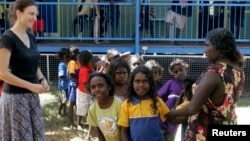Beginning next week, school attendance will be linked to welfare payments for parents in Aboriginal lands in South Australia. If parents don't send their children to school, they could lose state benefits. But the Australian prime minister's chief adviser on Indigenous affairs is urging the government to take a less punitive approach.
Ambitious targets have been set to bring indigenous school attendance up to Australia’s national average of around 90 per cent. It will be a tough challenge. In some remote settlements official figures show that almost 90 per cent of Aboriginal children struggle to read and write. Barely half stay at school beyond the age of 15.
In tribal areas in South Australia, jobless parents who don't send their children to school could now lose part of their welfare payments. Government officials believe the measures will force families to take education more seriously. It is reported that fewer children are attending class in South Australia’s Aboriginal lands now than in 2013
But Warren Mundine, the government’s chief adviser on Aboriginal affairs, believes the punitive approach is misguided.
“We need to work with parents and we need to work with communities because we are making a massive cultural change here. I'm talking about that the communities where we're working didn't have this thing about going to school and what was school about," he said. "We need to get communities to get ownership of that and I think if we get clan leaders saying the same thing then that's where the big change is going to go. Now, I know that governments and that find that punitive measures need to happen and that but I think they're really a last resort.”
A lack of education gives indigenous teenagers few chances to escape the relentless cycle of high unemployment, ill health and alcohol abuse that ravages many indigenous communities.
Australia has about 670,000 indigenous people, just under three per cent of the population. But compared to the non-indigenous community, they face disadvantage at almost every turn.








